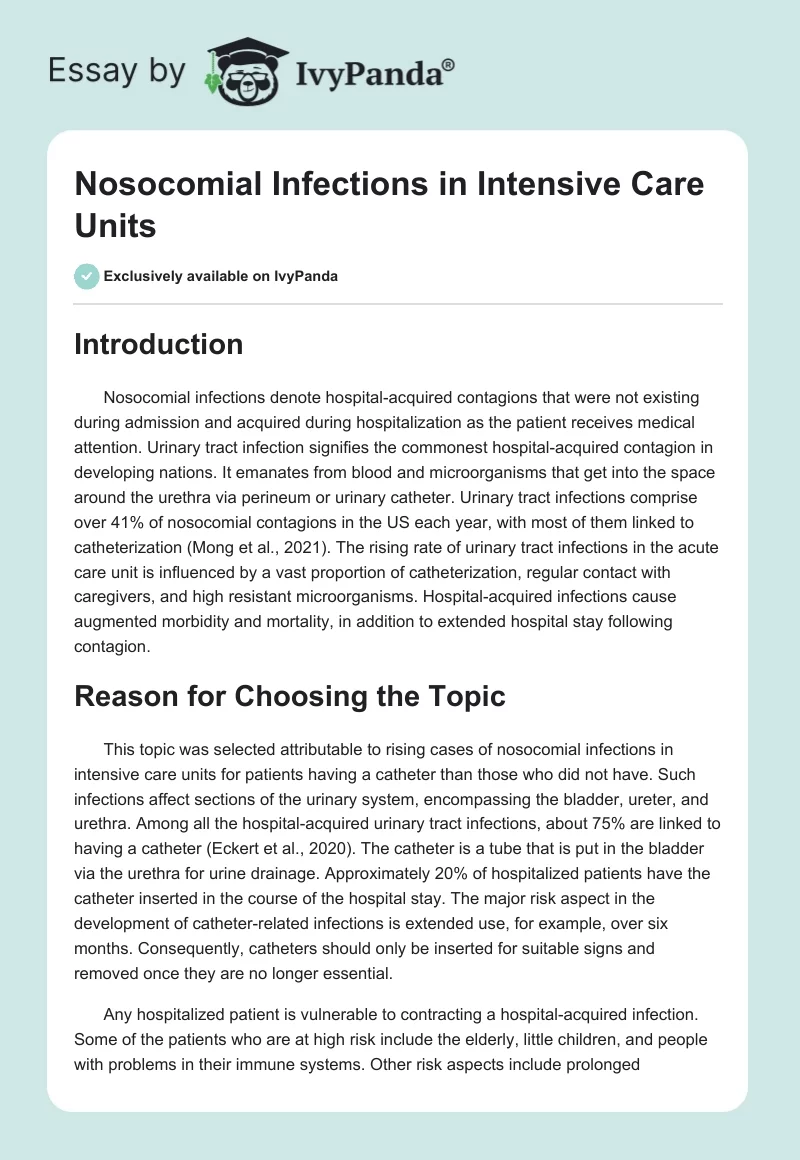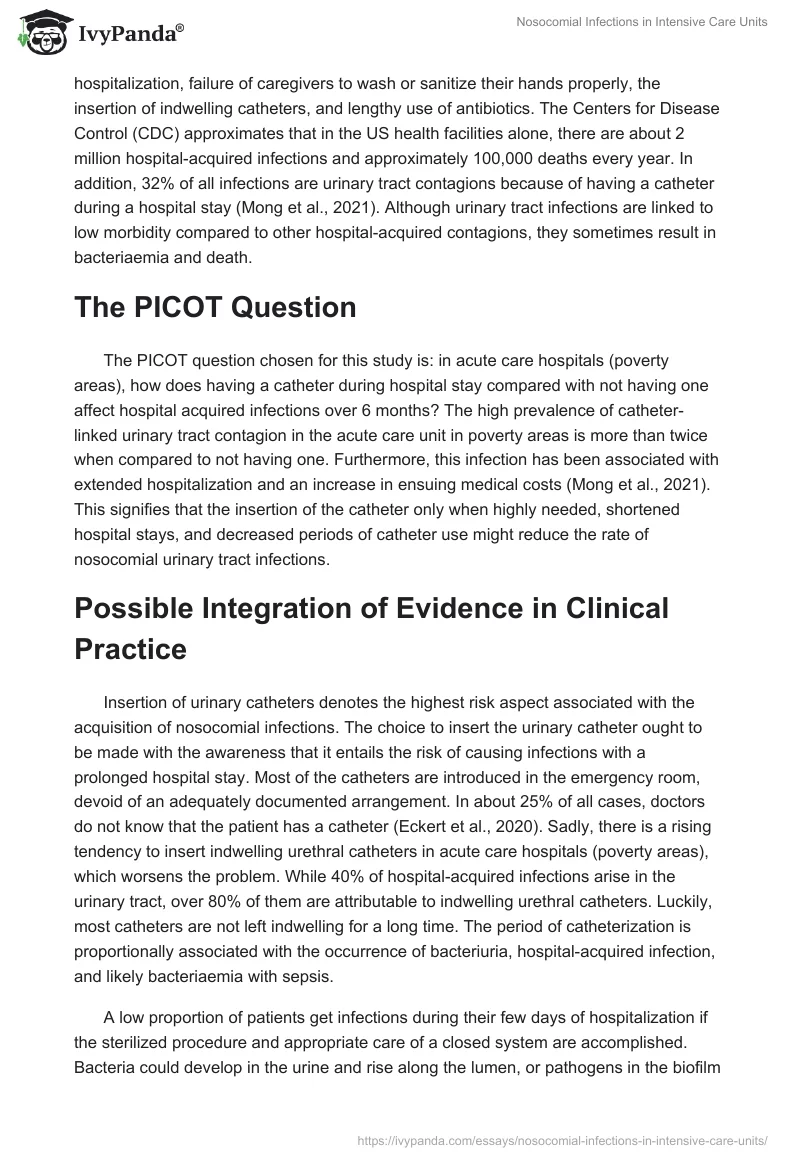Introduction
Nosocomial infections denote hospital-acquired contagions that were not existing during admission and acquired during hospitalization as the patient receives medical attention. Urinary tract infection signifies the commonest hospital-acquired contagion in developing nations. It emanates from blood and microorganisms that get into the space around the urethra via perineum or urinary catheter. Urinary tract infections comprise over 41% of nosocomial contagions in the US each year, with most of them linked to catheterization (Mong et al., 2021). The rising rate of urinary tract infections in the acute care unit is influenced by a vast proportion of catheterization, regular contact with caregivers, and high resistant microorganisms. Hospital-acquired infections cause augmented morbidity and mortality, in addition to extended hospital stay following contagion.
Reason for Choosing the Topic
This topic was selected attributable to rising cases of nosocomial infections in intensive care units for patients having a catheter than those who did not have. Such infections affect sections of the urinary system, encompassing the bladder, ureter, and urethra. Among all the hospital-acquired urinary tract infections, about 75% are linked to having a catheter (Eckert et al., 2020). The catheter is a tube that is put in the bladder via the urethra for urine drainage. Approximately 20% of hospitalized patients have the catheter inserted in the course of the hospital stay. The major risk aspect in the development of catheter-related infections is extended use, for example, over six months. Consequently, catheters should only be inserted for suitable signs and removed once they are no longer essential.
Any hospitalized patient is vulnerable to contracting a hospital-acquired infection. Some of the patients who are at high risk include the elderly, little children, and people with problems in their immune systems. Other risk aspects include prolonged hospitalization, failure of caregivers to wash or sanitize their hands properly, the insertion of indwelling catheters, and lengthy use of antibiotics. The Centers for Disease Control (CDC) approximates that in the US health facilities alone, there are about 2 million hospital-acquired infections and approximately 100,000 deaths every year. In addition, 32% of all infections are urinary tract contagions because of having a catheter during a hospital stay (Mong et al., 2021). Although urinary tract infections are linked to low morbidity compared to other hospital-acquired contagions, they sometimes result in bacteriaemia and death.
The PICOT Question
The PICOT question chosen for this study is: in acute care hospitals (poverty areas), how does having a catheter during hospital stay compared with not having one affect hospital acquired infections over 6 months? The high prevalence of catheter-linked urinary tract contagion in the acute care unit in poverty areas is more than twice when compared to not having one. Furthermore, this infection has been associated with extended hospitalization and an increase in ensuing medical costs (Mong et al., 2021). This signifies that the insertion of the catheter only when highly needed, shortened hospital stays, and decreased periods of catheter use might reduce the rate of nosocomial urinary tract infections.
Possible Integration of Evidence in Clinical Practice
Insertion of urinary catheters denotes the highest risk aspect associated with the acquisition of nosocomial infections. The choice to insert the urinary catheter ought to be made with the awareness that it entails the risk of causing infections with a prolonged hospital stay. Most of the catheters are introduced in the emergency room, devoid of an adequately documented arrangement. In about 25% of all cases, doctors do not know that the patient has a catheter (Eckert et al., 2020). Sadly, there is a rising tendency to insert indwelling urethral catheters in acute care hospitals (poverty areas), which worsens the problem. While 40% of hospital-acquired infections arise in the urinary tract, over 80% of them are attributable to indwelling urethral catheters. Luckily, most catheters are not left indwelling for a long time. The period of catheterization is proportionally associated with the occurrence of bacteriuria, hospital-acquired infection, and likely bacteriaemia with sepsis.
A low proportion of patients get infections during their few days of hospitalization if the sterilized procedure and appropriate care of a closed system are accomplished. Bacteria could develop in the urine and rise along the lumen, or pathogens in the biofilm outside the catheter might cause infections in the bladder. Although external sources of pathogens on or close to the patient might cause infections, most microorganisms emanate from patients’ intestinal flora (Mong et al., 2021). The main morbid occurrences related to having a catheter are fever and probable development of bacteriaemia with sepsis. Timely detection of infections and prevention of their progress, particularly in high-risk individuals, is paramount. There is a need for increased research to establish practices of averting infection past the sterilized closed system.
Methods to Evaluate the Effectiveness of Implementation
With increased research, numerous measures have been established to prevent hospital-acquired infections. Such practices encompass the establishment of nosocomial infection control boards, regular culture from varying hospital units, training and development for all health professionals, application of enhanced infectious waste disposal practices, and sterilizing hands before surgical operations. However, hospital-acquired infections have continued to generate countless complications during treatment, encompassing extended hospital stay, augmented use of medication, and high lab costs (Eckert et al., 2020). Diversity of pathogens, increased medical interventions, prolonged use of a broad scope of antibiotics, and rising significance of prevention, diagnosis, and treatment are some of the significant factors behind intensified research concerning hospital-acquired infections. Patients should be advised to alert doctors whenever they feel that the catheter might be blocked or when they start passing considerably significant elements of debris or grumes. The risk of hospital-acquired infection rises by about 5% to 10% with each day of catheter usage. Therefore, it is essential to check the aseptic method during catheterization carefully, think about substitutes to catheterization, and minimize the period of catheter use.
Conclusion
Nosocomial infections designate hospital-acquired contagions that were not extant during admission and developed during hospitalization as the patient gets medical attention. They cause augmented morbidity and deaths, in addition to lengthy hospital stays following contagion. Insertion of urinary catheters represents the highest risk aspect linked to the acquisition of nosocomial infections. The catheter is a conduit that is put in the bladder via the urethra for urine passage. This topic was chosen attributable to rising instances of nosocomial infections in acute care units for patients having a catheter than those who did not have. Among all nosocomial urinary tract infections, about 75% are associated with having a catheter. The critical risk aspect in the development of catheter-connected infections is prolonged usage, for example, more than six months. With improved research, several measures have been established to avert hospital-acquired infections.
References
Eckert, L., Mattia, L., Patel, S., Okumura, R., Reynolds, P., & Stuiver, I. (2020). Reducing the risk of indwelling catheter–associated urinary tract infection in female patients by implementing an alternative female external urinary collection device: A quality improvement project. Journal of Wound Ostomy & Continence Nursing, 47(1), 50-53.
Mong, I., Ramoo, V., Ponnampalavanar, S., Chong, M. C., & Wan Nawawi, W. N. F. (2021). Knowledge, attitude and practice in relation to catheter‐associated urinary tract infection (CAUTI) prevention: A cross‐sectional study. Journal of Clinical Nursing, 1(1), 1-10. Web.


